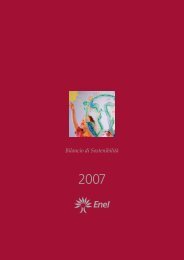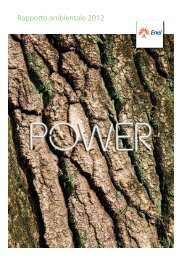Annual Report 2010 - Enel.com
Annual Report 2010 - Enel.com
Annual Report 2010 - Enel.com
You also want an ePaper? Increase the reach of your titles
YUMPU automatically turns print PDFs into web optimized ePapers that Google loves.
the ARENH price will be set with a ministerial decree,<br />
using the level of the TaRTAM at December 31, <strong>2010</strong><br />
as a benchmark; as from 2013 the ARENH price will be<br />
determined directly by CRE;<br />
> each supplier shall provide direct or indirect guarantees<br />
of capacity for consumption reduction and electricity<br />
generation: this could give rise to the formation of a capacity<br />
market, presumably in operation as from 2015;<br />
> the number of CRE <strong>com</strong>missioners has been reduced,<br />
although CRE’s responsibilities will increase within the<br />
scope of the duties assigned to it under the NOME Act;<br />
> starting from 2015 the regulated rates for major electricity<br />
consumers will be eliminated, while the regulated<br />
rates for the sale of electricity to minor consumers<br />
will be maintained;<br />
> a new local electricity consumption tax will be introduced<br />
(TLE) for customers with a supply contract of<br />
more than 250 kVA;<br />
> payment of connection costs is transferred to the generation<br />
<strong>com</strong>panies in order to reduce the impact on distribution<br />
<strong>com</strong>panies and to contain requests for connection<br />
made by generators using renewable energy<br />
resources.<br />
Recently, France’s ministers for energy and for the economy<br />
re<strong>com</strong>mended the establishment of new <strong>com</strong>mittee<br />
headed by Paul Champsaur to set the ARENH price.<br />
Poniatowski Act<br />
On June 8, <strong>2010</strong> the Poniatowski Act was officially published.<br />
It introduces the option for final customers who<br />
have transferred to the free market to return to a regulated<br />
supply market, although until 2015 they must remain<br />
in the free market for at least one year. The law also<br />
extends the TaRTAM until December <strong>2010</strong>. The rates was<br />
extended further during the Senate debate on the NOME<br />
Act: the TaRTAM will therefore remain in effect until the<br />
actual implementation of the ARENH mechanism.<br />
Taxation<br />
A new tax, the IFER (Imposition Forfaitaire sur les Entreprises<br />
de Réseaux), introduced with the <strong>2010</strong> Finance Act, is<br />
in effect starting from <strong>2010</strong>. The new tax of €2,913/MW/<br />
year, will be paid by hydroelectric and wind power plants<br />
with a capacity in excess of 100 kW and by nuclear and<br />
conventional power plants with a capacity in excess of 50<br />
MW. The 2011 Finance Act increased the IFER for wind<br />
plants (€5,000/MW/year).<br />
Roussely <strong>Report</strong> and nuclear policy<br />
On May 11, <strong>2010</strong> a confidential report prepared under the<br />
guidance of François Roussely was sent to the French President.<br />
In July <strong>2010</strong> a summary of the report was published,<br />
containing guidelines for France’s nuclear energy policy.<br />
Among its objectives, the report calls for forging a partnership<br />
between EDF and AREVA and making them more<br />
<strong>com</strong>petitive in the global nuclear energy market in order<br />
to create opportunities for exporting French technology.<br />
The report suggests ensuring that the construction of the<br />
Flamanville 3 plant proceed as quickly and cost-effectively<br />
as possible and calls for making investments to expand existing<br />
plant availability. Recognizing that certain problems<br />
faced by EPR plants are the result of the large number of<br />
safety standards imposed during construction, the <strong>Report</strong><br />
re<strong>com</strong>mends greater cooperation between EDF and the<br />
French nuclear safety authority (Autorité de Sûreté Nucléaire<br />
- ASN) concerning safety measures and the operational<br />
life of French nuclear power plants to make them more<br />
<strong>com</strong>petitive. Finally, the report suggests that smaller-scale<br />
plants (1,000-1,150 MW), for which there is higher demand<br />
internationally, be added to France’s portfolio.<br />
Regulated electricity rates<br />
On August 15, <strong>2010</strong> the French Energy Ministry set the<br />
new final regulated electricity rates, featuring average<br />
increases of 4%, 4.5% and 5.5% for small, medium and<br />
large customers, respectively.<br />
TaRTAM rates, in effect through December <strong>2010</strong>, were<br />
also increased by an average of 0.6%. The 2011 Finance<br />
Act set out a new regulatory framework for the operation<br />
of the electricity public service contribution (CSPE), raising<br />
that <strong>com</strong>ponent of electricity rates from €4.5/MWh to<br />
€7.5/MWh.<br />
Russia<br />
Capacity market<br />
The volumes of capacity sold on the free market are rising<br />
in line with the volume of liberalized electricity envisaged<br />
in the decree of April 7, 2007: since January 1, 2011, all<br />
capacity for non-household customers is sold on the free<br />
market.<br />
At the conclusion of the long consultation process, in February<br />
and April <strong>2010</strong> the government published two decrees<br />
regulating the new long-term capacity market and<br />
setting out the pricing parameters for both new and existing<br />
capacity.<br />
61









